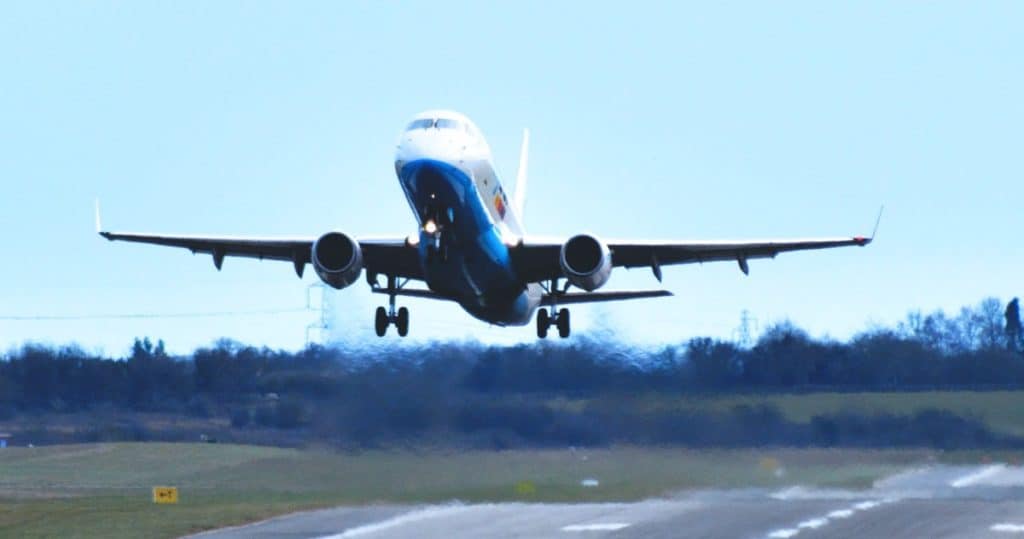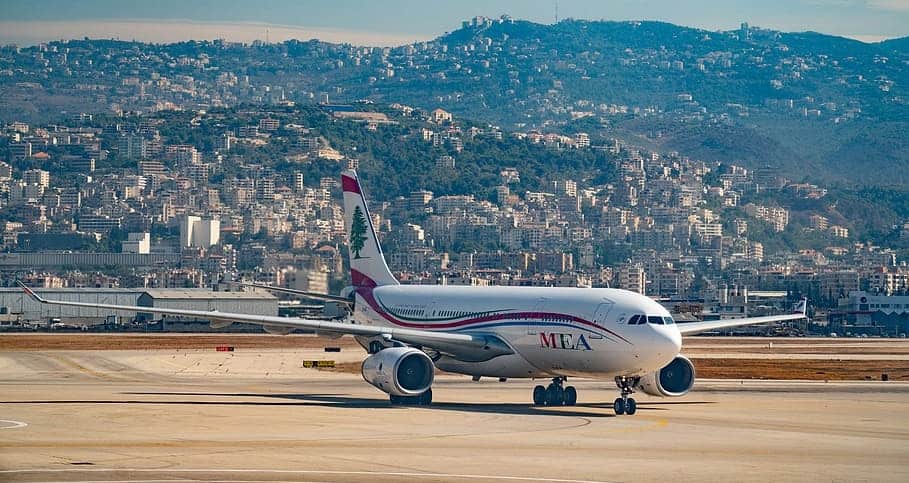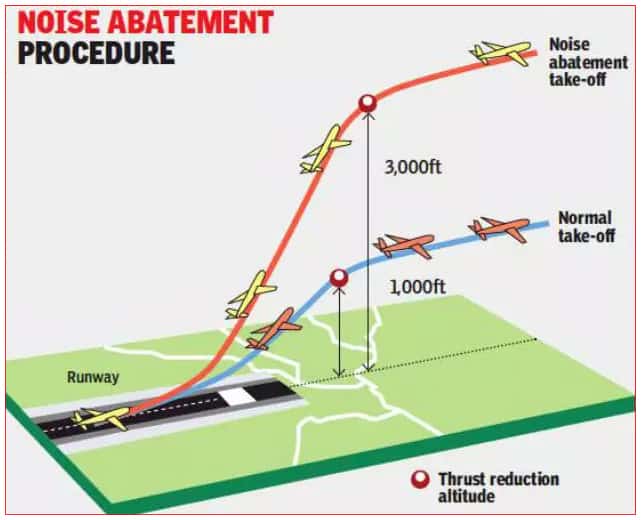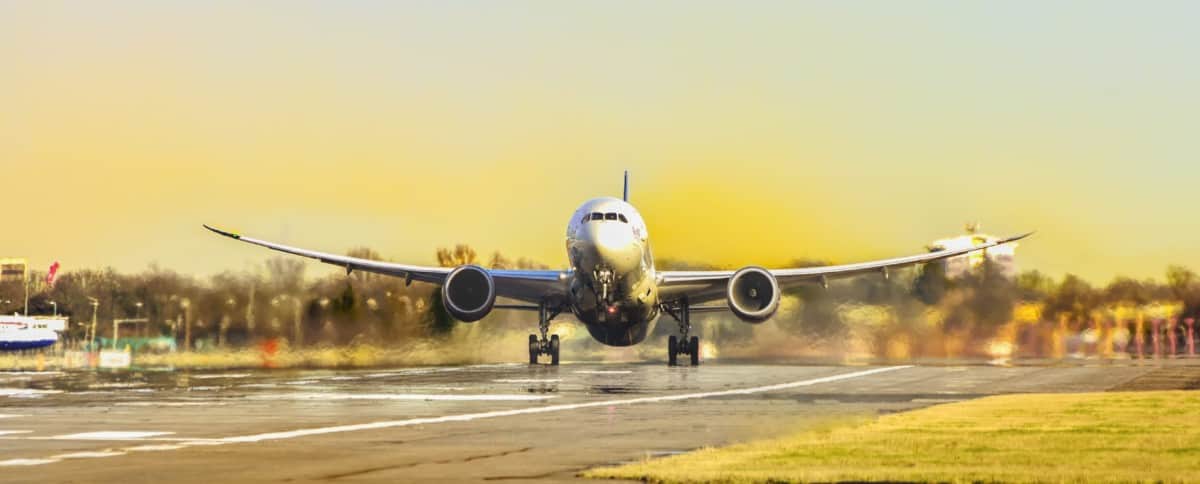
This week I was on a plane heading to work and there was a very obvious throttle back of the engines not long after the wheels left the ground. Normally I don’t even notice as I’ve flown so much but for whatever reason, this flight grabbed my attention and I thought it would be great for an explanation.
Pilots reduce power after takeoff mostly because of noise abatement procedures at the airport. Engines produce their most noise at takeoff power & to keep the local neighbors happy airport departure procedures call for a reduction in power from 800 feet to 3000 feet to reduce noise pollution.
Noise abatement is the main reason why pilots reduce thrust on the aircraft while in the climb, but there are also other reasons. Read on to find out what they are…
Aircraft Noise Abatement
Reducing the noise created by an airplane engine is one of the biggest design requirements for engine manufacturers like Rolls-Royce, General Electric, Pratt & Whitney, etc. As our airspace gets busier more aircraft are being crammed into the daylight operating hours of the world’s airports. So why not run the airports 24/7?
Most airports are surrounded by hundreds, if not thousands of homes, and even though the owners probably knew there was an airport there before buying the house, keeping noise to a minimum is paramount.
To help keep aircraft noise to a minimum many airports use multiple techniques:
- Noise Abatement Departure Programs & Procedures
- Nighttime Airport Closure
- Preferred Runways
By using all or some of these techniques the airport management can drastically reduce the number of noise complaints they receive, but no matter what they do there will always be that one regular complainer!

Now the airport has its noise reduction techniques in place, what can the pilots and aircraft do to help minimize the sound the aircraft create?
Thrust Cutback
The FAA has done a lot of testing on aircraft noise on takeoff and has issued the following guidelines for airports to adopt in their Departure Procedures that the pilots must follow.
FAA Advisory Circular AC 91-53A lists the recommendations – You can view it Here.
The recommendations are as follows:
- Once the aircraft passes 800ft above the surface the pilots must initiate ‘Thrust Cutback’ in other words take the foot off the gas a little. This can be done manually by the pilots or automatically using an aircraft equipped with Automatic Thrust Cutback. The Boeing Quiet Climb System is an example
- The aircraft must remain in this reduced thrust configuration until passing 3000ft above the surface
- After passing 3000ft the pilots or aircraft can resume normal climb power

This Trust Cutback is why you hear the engines reduce power just after takeoff and all to reduce the noise to the local communities below you.
Boeing’s Quiet Climb System
Incorporated into most of Boeing’s aircraft is a proprietary system called the Quiet Climb. This is an automatic trust reduction system that allows the aircraft avionics to automatically reduce thrust once it senses passing through 800ft above the ground.
The Quiet climb system automatically reduces thrust to allow set climb gradients if an engine were to fail. By allowing the system to calculate the minimum power required to meet these gradients it can reduce as much thrust as possible allowing for the greatest noise reduction.
For a B737-800 a typical takeoff power would be around 92% N1 on each engine. During the Thrust Cutback, this engine power will be automatically reduced to 84% N1. This reduced power setting will ensure the aircraft meets the minimum climb gradient required for the number of engines it has.
Minimum Climb Gradients During an Engine Failure:
- Aircraft with 2 Engines = 1.2°
- Aircraft with 3 Engines = 1.5°
- Aircraft with 4 Engines = 1.7°
If an engine fails after Thrust Cutback the remaining engine/s must maintain this minimum climb gradient.
Once the aircraft has passed 3000ft above the ground the Quiet Climb System automatically restores the full climb power (92.3% N1 for example). This system helps to reduce pilot workload at a time when the workload is very high, with the added benefit of optimizing thrust to keep noise to a minimum it is a very welcomed system to local residents.

Join My Newsletter & Get Great Tips, Information and Experiences To Help You Become a Superb Pilot!
Aircraft Altitude Restrictions
Another reason you may hear the thrust of the engines reduces is because Air Traffic Control issue the pilot with an Altitude Restriction.
An altitude restriction is just what it sounds like – it’s a limit on how high the pilot can climb. This can be because of various reasons like other traffic, weather, or for separation purposes. Whatever the reason, the pilots can only climb to, but not exceed that altitude until cleared to do so by the air traffic controller.

When climbing, the aircraft needs more power than level flight, so when the aircraft starts to reach the imposed altitude restriction either the pilots or the aircraft will begin to level off and reduce the power to prevent the aircraft from climbing or speeding up.
If the power is not reduced once leveled off, the aircraft will begin to speed up, but there is a 250knot speed limit for all aircraft under 10,000 feet. Breaking this speed limit is just as punishable as busting the altitude restriction.
This reduction in power during the leveling-off phase is another reason why you hear the thrust being reduced.
Why Do Aircraft Engines Accelerate, Pause & Then Takeoff?
Just before the plane has got airborne and the Thrust Cutback System has kicked in you may have noticed a short pause in engine noise when the aircraft is starting to accelerate at the start of the runway, why is that?
Aircraft engines take a second or two to spool up after the pilot has applied the throttle. The short pause you hear is the pilots ensuring that both engines have responded to the throttle increase and are spooling up together.
If one engine were to spool up and the other stayed idle the tremendous thrust produced by just one engine could cause the aircraft to veer off in one direction if not caught quickly enough by the pilots.
After the short pause and engine check, the pilots then accelerate all the engines to take off power knowing that they have all responded to the initial power request and are both working correctly.
To Finish
Hearing engine tone changing during initial takeoff and climb is just part of the procedures for taking off. Ensuring the aircraft is working correctly and flying neighborly are major factors in ensuring a successful flight.
As more aircraft pack our skies, the quieter they need to become. By making pilots reduce thrust for a minute or so it is surprising how much quieter a large jet airliner can become!
We will never get away from the noise completely anytime soon so by using all the techniques to reduce aircraft noise, the better our airport noise pollution will be.
Further Reading
If you found this article interesting and would like to keep reading, I highly recommend the following articles from my blog:


